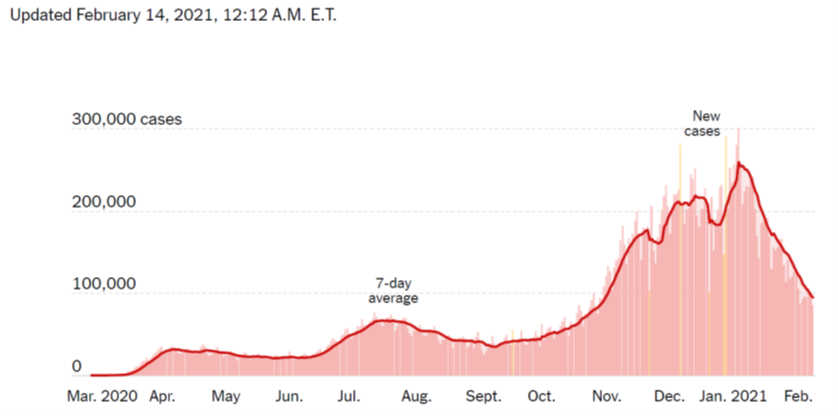COVID status: all good news
February 14, 2021 By Alan SalzbergA few weeks ago, I wrote that the pandemic has peaked (see this link for post about NY and this link for the post about the country). So where are we now?
An exponential decline in cases
Nationally, cases have gone from a peak of 300,000 on Jan. 8 (and a 7-day average a bit below that) to their current level of about 100,000 a day (see the NY Times graph below).

This 60% drop in one month bodes well, and it occurred before any appreciable effect from vaccinations. This drop has occurred despite loosening of requirements virtually everywhere. And just about every place in the country is still dropping. For NY's part, the positivity rate of just over 6% a month ago has dropped to less than 4% now.
For reasons described in my past post (see here), I think we would be well-served to wait a few more weeks to loosen restrictions more, so we can get virus rates get even lower and more of the over 65s are vaccinated. But, I am confident that even with further loosening COVID is on an unstoppable downward trajectory.
I'm not writing about deaths today, but we will see that, in a few weeks, deaths will also have dramatically declined (deaths follow cases by a few weeks), and even more so due to older people getting vaccinated.
We are Vaccinating More People
Bloomberg's vaccination tracker (see here) shows that about 1 in 8 people in the US have gotten their first dose. More importantly, the rate of vaccination has increased dramatically. We have administered an average of 1.6 million shots a day in the last week, with a couple days of >2 million vaccinated. That shows we have the capability right now to do >2 million a day every day. Sure, there is still a lot to complain about regarding vaccine distribution, but all those things are really positives -- fixable problems that will only further increase the rates of vaccination. I believe that in a few weeks, we will be at 3 million a day -- that's 10 million fully vaccinated people per week. As you see below, we will have enough for this pace of vaccination soon, and more soon after that.
We are getting more vaccine
Pfizer and Moderna have promised to deliver a total of 220 million doses by the end of March, of which around 70 million have been received. So there will be another 150 million doses available in the next 6 weeks (almost 4 million a day). Another 200 million doses are coming, Pfizer's 100 million by the end of May and Moderna's 100 million by the end of June, so that's around 80 million a month in April and May, and the balance of the 200 million in June. Thus, by the end of June, we will have enough shots to fully vaccinate 210 million people.
These numbers do not include any of the other vaccines, which will likely also be available in fairly short order (at least Johnson and Johnson, and likely AstraZeneca, will have approval by the end of March).
The Variants are Still a Red Herring
The public alarm about the variants is unfounded, because they remain a tiny percentage of cases here. At our current rate of decline, COVID will be much less prevalent by the time the variants have a true foothold here. Most models show the British variant becoming dominant here around the end of March. This is not so scary in the world we are looking at - one in which infection rates are far lower and most vulnerable have been vaccinated. The Pfizer and Moderna vaccines appear to be effective for both the British and South African variants (though slightly less effective for the South African variant: see here). This is not to say scientists should not worry about mutations-- they will surely need to develop new formulations of vaccines and booster shots for the long haul, as some mutations will be beyond the current vaccines' reach. Instead, what I'm saying is that in defeating COVID in the next few months, the variants are not going to be an issue, because the vaccines still work and cases are rapidly dropping anyway.
Spring is Almost Here
Let's not forget that while we are in the depths of winter now, it will be April in six weeks, and increased outdoor activity will naturally work to hasten the decline of transmission, as it did last year.
Conclusion
A very good Valentine's day, at least as far as worries about COVID are concerned.